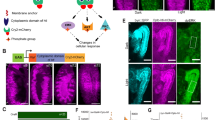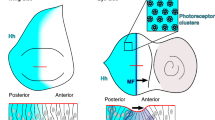Abstract
DIFFERENTIATION of the Drosophila retina is asynchronous: it starts at the posterior margin of the eye imaginal disc and progresses anteriorly over two days. During this time the disc continues to grow, increasing in size by approximately eightfold. An indentation in the epithelium, the morphogenetic furrow1, marks the front edge of the differentiation wave. Anterior progression of the furrow is thought to be driven by signals emanating from differentiating photoreceptor cells in the posterior eye disc2,3. A good candidate for such a signal is the product of the hedgehog (hh) gene4–7; it is expressed, and presumably secreted, by differentiating photoreceptors and its function is required for continued furrow movement2,3. Here we show that ectopic expression of hedgehog sets in motion ectopic furrows in the anterior eye disc. In addition to changes in cell shape, these ectopic furrows are associated with a tightly orchestrated series of events, including proliferation, cell cycle synchronization and pattern formation, that parallel normal furrow progression. We propose that the morphogenetic furrow coincides with a transient boundary that coordinates growth and differentiation of the eye disc, and that hedgehog is necessary and sufficient to propagate this boundary across the epithelium.
This is a preview of subscription content, access via your institution
Access options
Subscribe to this journal
Receive 51 print issues and online access
$199.00 per year
only $3.90 per issue
Buy this article
- Purchase on Springer Link
- Instant access to full article PDF
Prices may be subject to local taxes which are calculated during checkout
Similar content being viewed by others
References
Ready, D. F., Hanson, T. E. & Benzer, S. Devl Biol. 53, 217–240 (1976).
Ma, C., Zhou, Y., Beachy, P. A. & Moses, K. Cell 75, 927–938 (1993).
Heberlein, U., Wolff, T. & Rubin, G. M. Cell 75, 913–926 (1993).
Mohler, J. & Vani, K. Development 115, 957–971 (1992).
Lee, J. J., von Kessler, D. P., Parks, S. & Beachy, P. A. Cell 71, 33–50 (1992).
Tabata, T., Eaton, S. & Kornberg, T. B. Genes Dev. 6, 2635–2645 (1992).
Tashiro, S. et al. Gene 124, 183–189 (1993).
Padgett, R. W., St Johnston, D. & Gelbart, W. M. Nature 325, 81–84 (1987).
Blackman, R. K., Sanicola, M., Raftery, L. A., Gillevet, T. & Gelbart, W. M. Development 111, 657–666 (1991).
Struhl, G. & Basler, K. Cell 72, 527–540 (1993).
Basler, K. & Struhl, G. Nature 368, 208–214 (1994).
Robinow, S. & White, K. Devl Biol. 126, 294–303 (1988).
Moses, K., Ellis, M. C. & Rubin, G. M. Nature 340, 531–536 (1989).
Krämer, H., Cagan, R. L. & Zipursky, S. L. Nature 352, 207–212 (1991).
Ingham, P. W. Curr. Opin. genet. Dev. 1, 261–267 (1991).
Capdevila, J., Estrada, M. P., Sanchez, H. E. & Guerrero, I. EMBO J. 13, 71–82 (1994).
Tabata, T. & Kornberg, T. B. Cell 76, 89–102 (1994).
Jarman, A. P., Grau, Y., Jan, L. Y. & Jan, Y. N. Cell 73, 1307–1321 (1993).
Carroll, S. B. & Whyte, J. S. Genes Dev. 3, 905–916 (1989).
Jarman, A. P., Grell, F. H., Ackerman, L., Jan, L. Y. & Jan, Y. N. Nature 369, 398–400 (1994).
Brown, N. L., Sattler, C. A., Markey, D. R. & Carroll, S. B. Development 113, 1245–1256 (1991).
Brown, N. L., Sattler, C. A., Paddock, S. W. & Carroll, S. B. Cell (in the press).
Thomas, B. J., Gunning, D. A., Cho, J. & Zipursky, S. L. Cell 77, 1003–1014 (1994).
Thomas, B. J. & Zipursky, S. L. Trends Cell Biol. 4, 389–393 (1994).
Edgar, B. A. & O'Farrell, P. H. Cell 62, 469–480 (1990).
Alphey, L. et al. Cell 69, 977–988 (1992).
Lebovitz, R. M. & Ready, D. F. Devl Biol. 117, 663–671 (1986).
Tautz, D. & Pfeifle, C. Chromosoma 98, 81–85 (1989).
Kimmel, B. E., Heberlein, U. & Rubin, G. M. Genes Dev. 4, 712–727 (1990).
Simon, J. A., Sutton, R. B., Lobell, R. L., Glaser, R. L. & Lis, J. T. Cell 40, 805–817 (1985).
Author information
Authors and Affiliations
Rights and permissions
About this article
Cite this article
Heberlein, U., Singh, C., Luk, A. et al. Growth and differentiation in the Drosophila eye coordinated by hedgehog. Nature 373, 709–711 (1995). https://doi.org/10.1038/373709a0
Received:
Accepted:
Issue Date:
DOI: https://doi.org/10.1038/373709a0
This article is cited by
-
Human eye conditions: insights from the fly eye
Human Genetics (2019)
-
Using Drosophila melanogaster to map human cancer pathways
Nature Reviews Cancer (2005)
-
The potential of marrow stromal cells in stem cell therapy
Eye (2001)
Comments
By submitting a comment you agree to abide by our Terms and Community Guidelines. If you find something abusive or that does not comply with our terms or guidelines please flag it as inappropriate.



